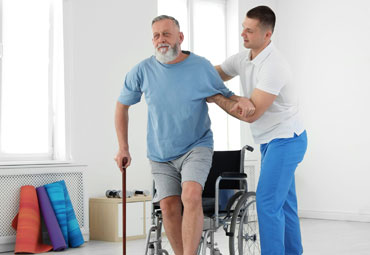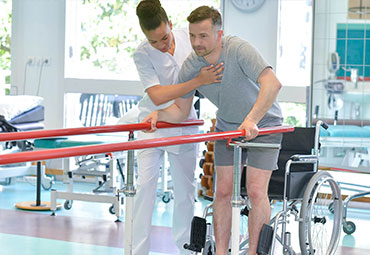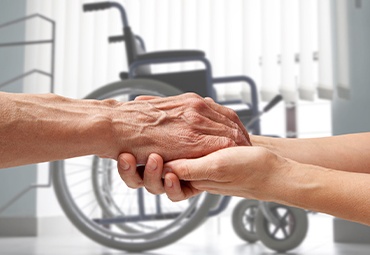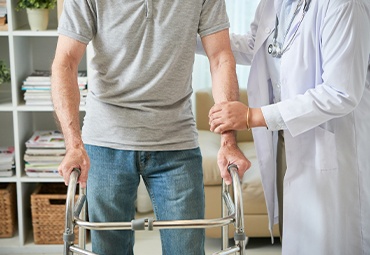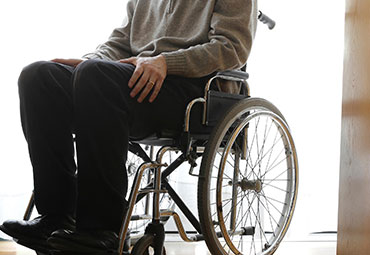
Paraplegia, sometimes called partial paralysis refers to paralysis that occurs in the lower half of the body. Paraplegia is almost always the caused by damage to the brain, spinal cord, or both. People with paraplegia will experience symptoms related to mobility problems and may require the use of a wheelchair. However, long-term paraplegia treatment options exist to help reduce symptoms and complications related with paraplegia. If you or a loved one is a paraplegic, it is important to learn about the condition and how to live with it. This article will discuss what paraplegia is, as well as the causes of paraplegia, its symptoms and treatment for paraplegic patients.
Paraplegia meaning
Paraplegia, is a form of paralysis in which function is substantially reduced from below the level of injury ie in the lower body. Paraplegia mainly affects the trunk, legs, and the pelvic region, resulting in loss of movement. Most paraplegics (people with paraplegia) have perfectly healthy legs but are unable to use them. The problem resides in either their brain or spinal cord, which cannot send or receive signals to the lower body due to an injury or disease.
Causes of Paraplegia
Paraplegia is a condition which in most cases, is caused by injury or trauma to the spinal cord.
Often, spinal cord injuries to the upper (thoracic spine), lumbar (lower back), or sacral (tail bone) spinal cord are to blame.
The spinal cord runs through the centre of the bony spine. It is like a system of telephone wires which conduct messages from the brain, through the nerves, to all parts of the body. When spinal cord injuries occur, signals cannot travel to and from the lower regions of the body, and the body is prevented from sending signals back up the spinal cord to the brain, resulting into different types of paralysis.
Most spinal cord and brain injuries are traumatic in nature, which means they result from a sudden blow to the area, usually due to an accident. Some injuries, though, are non-traumatic, and usually attributable to diseases or genetic anomalies.
Some chronic conditions can also lead to paraplegia. Conditions that might cause paraplegia include:
- tumors or lesions of the spine or brain
- neurological conditions, such as stroke or cerebral palsy
- autoimmune conditions, such as multiple sclerosis
- Oxygen deprivation to the brain or spinal cord due to choking, childbirth complications, and other injuries
Types of Paraplegia
While paraplegia is typically characterized by the paralysis of the legs, there are different types of paraplegia where the symptoms can vary in severity. Some of types of paraplegia include:
(a) Incomplete or Partial Paraplegia (Paraparesis)
In some cases, paraplegia does not fully affect both legs. For example, one leg may be fully paralyzed, while the other has limited or even normal function. This is known as incomplete paraplegia, and can be the result of many different conditions.
(b) Complete Paraplegia
Cases of paraplegia when the patient retains no feeling or function in their legs whatsoever are referred to as complete paraplegia. A complete paraplegic is unable to use both legs and may experience other issues, such as a loss of bladder and bowel control.
Complete paraplegia is common with complete spinal cord injuries in the thoracic and lumbar regions of the spine.
(c) Hereditary Spastic Paraplegia
The National Institute of Neurological Disorders and Stroke (NINDS) defines hereditary spastic paraplegia (or HSP) as “a group of inherited disorders that are characterized by progressive weakness and spasticity (stiffness) of the legs.”
This variation of paraplegia can be inherited from a parent, so it is important to know if any family members have the condition.
Paraplegia Vs Paraparesis
Paraplegia vs paraparesis is a heavily debated topic. Simply put, they can be understood as:
- Paraplegia refers to a complete inability to move the legs.
- When some functionality remains in either leg, it is referred to as paraparesis. Paraparesis is closer to incomplete paraplegia where some functionality is retained (one leg may be dysfunctional while other may function normally)
Paraparesis (paraplegia) therefore refers to partial (-paresis) or complete (-plegia) loss of voluntary motor function in the pelvic limbs.[1]
Quadriplegia Vs Paraplegia
Both quadriplegia (or tetraplegia) and paraplegia are types of paralysis. Both conditions are typically the result of spinal cord injuries, traumatic brain injuries and diseases affecting the brain and spinal cord. Our Neuro Rehabilitation team is often faced by this question – What is the difference between quadriplegia and paraplegia?
The major difference between paraplegia vs quadriplegia is that:
- Paraplegia is a paralysis of the legs (only) and Quadriplegia is the paralysis of the legs and arms (both limbs)
- Spinal injuries to lumbar or sacral spine (lower spine) are likely to result in paraplegia while those in upper spine (thoracic) are likely to result into Quadriplegia.
There are some other forms of paralysis also. They include monoplegia, which affects one arm, and hemiplegia, which affects one leg and one arm on the same side of the body.
Paraplegia Symptoms
Signs and symptoms of paraplegia are highly variable for a paraplegic. Symptoms will depend upon how badly the spinal column has been damaged. As a first sign after spinal cord injury, the body seems to be in a spinal shock state which leads to flaccid paralysis and loss of muscle stretching.
Some of the most common signs and symptoms of paraplegia include:
- Loss of sensation and complete immobility in the lower body (legs and sometimes, abdomen)
- Problems while breathing, coughing or sneezing
- Intense pain and stinging sensation in the lower extremities
- Loss of control over bladder or bowel movement
- Loss of libido and change in sexual functions and fertility
- Changes in mood and depression
- Secondary infections due to loss of movement, particularly bedsores, UTIs
- Autonomic dysreflexia—rapid heartbeat, spikes in blood pressure
- Weight gain due to loss of physical activities (specially if the patient’s diet has not been adjusted)
Treatment Of Paraplegia
There are currently no treatments to prevent or reverse paraplegia. But there are things that people can do to speed their recovery and even potentially restore some of their legs’ functionality.
Paraplegia recovery can be a long and difficult process as paraplegics learn to cope with their paraplegia symptoms. There are numerous steps to recovering from paraplegia—steps that may change depending on the cause and severity of the condition.
Treatment Stage 1: Medication and Surgery
Paraplegia can be treated in the initial stages by medications. During the treatment, the doctor also makes it a point to prevent any underlying secondary problems like blood clots, pressure ulcers, bladder or bowel troubles, respiratory infections, etc. Sometimes, they may also suggest hospitalization or surgical procedures to improve the condition.
Treatment Stage 2: Rehabilitation
The first step may or may not include surgery. But the definitive next step is neuro rehab.
Generally speaking, intensive neuro rehabilitation gives you the best chance at recovery, particularly when you begin receiving therapy immediately after the injury. ReAble Neuro Rehabilitation offers comprehensive and highly rated in-patient rehabilitation, so if such a facility is near you, consider moving your recovery to that location.
Medical studies [2] have shown that an interdisciplinary approach is essential in rehabilitation in SCI, as in the other types of rehabilitation. The team consists of the patients’ family, physiotherapist, occupational therapist, dietician, psychologist, speech therapist and other consultant specialists as necessary.
Following the best practices and proven protocols for neuro rehabilitation, ReAble’s Paraplegia Neuro rehabilitation programme uses a multi-specialty approach. After a thorough assessment and understanding of the paraplegia condition, your program lead may prescribe physiotherapy to help with muscle pain and/or occupational therapy to help with muscle and mobility issues. Physical therapy can also help a person preserve their strength and range of motion. They may suggest and teach the patient to use assistive devices to support mobility, such as a wheelchair or a mobility scooter, as required. A nutritionist will help adjust the patient’s diet to ensure optimal weight and nutrition to support rehab efforts.
Learning how to live with paraplegia is important for the paraplegic and for those around them. When a loved one loses function in their legs, it requires everyone they know to adapt. Reable uses a team approach to help the patient and their family adapt to their new situation in the best possible manner. Call us now or connect with us by filling the form below and we will be happy to help!
Paraplegia? Ask for Call Back
Scientific References:
[1] Paraparesis (paraplegia), tetraparesis (tetraplegia), urinary/fecal incontinence. Spinal cord diseases. J N Kornegay, PMID: 1802259. Probl Vet Med. 1991 Sep;3(3):363-77.
[2] Rehabilitation of spinal cord injuries Kemal Nas, Levent Yazmalar, Volkan Şah, Abdulkadir Aydın, and KadriyeÖneş. World J Orthop. 2015 Jan 18; 6(1): 8–16.Published online 2015 Jan 18. doi: 10.5312/wjo.v6.i1.8
- Date:8 Jul, 2021
- Posted By:ReAble
- Categories:Paralysis, Spinal Cord Injury
- Tags: paraparesis, paraplegia, paraplegia vs paraparesis, quadriplegia vs paraplegia, spastic paraplegia, types of paralysis






